Mary C. Stinera, Steven L. Kuhna, Erksin Güleçb
Source - http://www.sciencedirect.com/science/article/pii/S004724841300016X
Journal of Human Evolution, Volume 64, Issue 5, May 2013, Pages 380–398
Abstract
Ten early Upper Paleolithic layers in Üçağızlı Cave I (41–29 uncalibrated ky BP) on the Hatay coast of southern Turkey preserve a rich and varied record of early Upper Paleolithic life, including the production and use of large numbers of shell ornaments. This study examines shell bead production, use, and discard in relation to site function and the diversity of on-site human activities. Four factors are expected to contribute to variation in the ornament assemblages, one environmental and three behavioral. The behavioral factors relate to winnowing for quality as a function of distance from the raw material source, changes in the size of user groups, and symbol standardization. The accumulation rates for shell beads, bones, and stone tools paralleled one another through time, indicating that ornament discard followed the pulse of daily life at this site. All stages of manufacture and use are well represented in each assemblage, and half or more of the ornaments show evidence of extended use. Changes in the local marine environment do not explain much of the variation in the assemblages, pointing instead to behavioral causes. The richness of shell types that were collected as raw material correlates to greater exploitation of edible marine shellfish and greater occupation intensity. Much of this variation in the ornament raw material was eliminated during the manufacture stage, almost certainly reflecting the influence of cultural norms. A focus on basket-shaped shells changed remarkably little over thousands of years, despite significant changes in other domains of technology. This last result suggests that beads were the most irreducible and conservative elements of more complex design traditions.
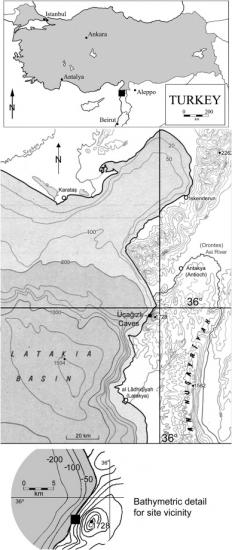
Figure 1. Location of the Üçağızlı Caves study area (black square) in the Hatay province of south-central Turkey, and (below) bathymetry in meters of the Mediterranean Sea off the Hatay-Lebanon coast and the path of the Orontes (Asi) River. Map section adapted from Legros and Bonnin (1991), International Bathymetric Chart of the Mediterranean (IBCM-Seismicity), UNESCO.
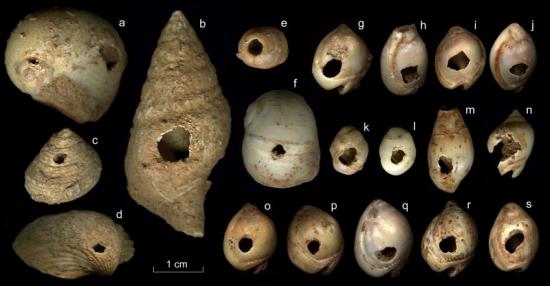
Figure 5. Typical perforated shell ornaments from various layers in Üçağızlı Cave I: (a) double-holed Naticarius stercusmuscarum (=millepunctata); (b) Euthria cornea, one of the rare large ornamental shells; (c) Gibbula sp. with hole in upper whorl; (d) Acanthocardia tuberculatum with holed umbo; (e) wave-worn Conus mediterraneus missing spire; (f) Naticarius sp; (g–j) holed Nassarius gibbosulus shells in varied stages of use-wear; (k–l) Theodoxus sp., one (l) heavily worn from use; (m) Melanopsis praemorsa, extensively wave-worn and subsequently perforated; (n) Nassarius (=Sphaeronassa) mutabilis, broken through perforation point; (o–s) holed N. gibbosulus shells in varied stages of use-wear.
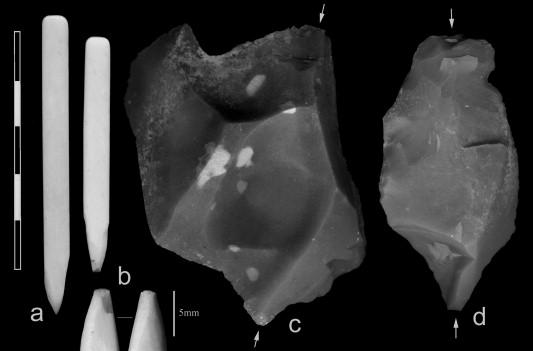
Figure 10. Examples of experimental punching tools: Cortical bone slivers, (a) unused and (b) used; flint flakes, (c) used and (d) unused. Arrows indicate alignment of tip and striking butt for the stone tools.
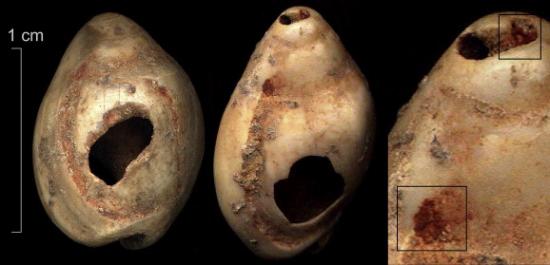
Figure 15. Red ochre traces on the exterior surfaces of Nassarius gibbosulus shells.
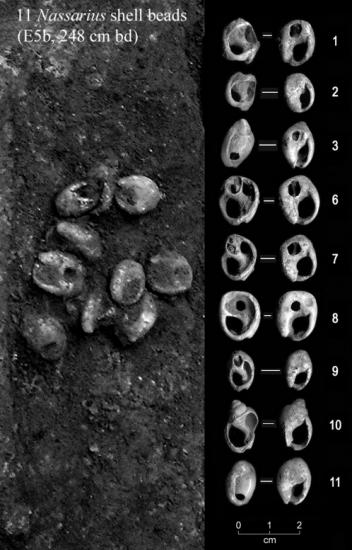
Figure 16. In situ concentration of 11 shell beads from Layer G at 248 cm below datum in Square E5b (left), and two views of each shell. All of the shells in the concentration are N. gibbosulus except no. 10, which is Nassarius (=Sphaeronassa) mutabilis